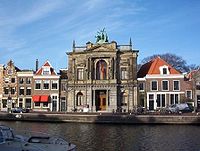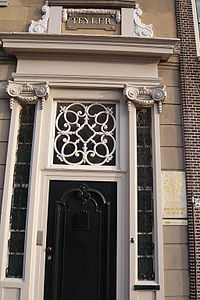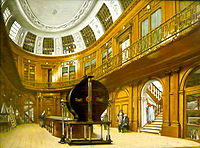
Teylers Museum
Encyclopedia

Haarlem
Haarlem is a municipality and a city in the Netherlands. It is the capital of the province of North Holland, the northern half of Holland, which at one time was the most powerful of the seven provinces of the Dutch Republic...
, is the oldest museum in the Netherlands
Netherlands
The Netherlands is a constituent country of the Kingdom of the Netherlands, located mainly in North-West Europe and with several islands in the Caribbean. Mainland Netherlands borders the North Sea to the north and west, Belgium to the south, and Germany to the east, and shares maritime borders...
. The museum is in the former home of Pieter Teyler van der Hulst
Pieter Teyler van der Hulst
Pieter Teyler van der Hulst was a wealthy Dutch Mennonite merchant, who died childless, leaving a legacy of two million florins to the pursuit of religion, arts and science in his hometown, that led to the formation of Teyler's Museum. This was not the value of his entire estate...
(1702–1778). He was a wealthy cloth merchant and Amsterdam
Amsterdam
Amsterdam is the largest city and the capital of the Netherlands. The current position of Amsterdam as capital city of the Kingdom of the Netherlands is governed by the constitution of August 24, 1815 and its successors. Amsterdam has a population of 783,364 within city limits, an urban population...
banker of Scottish
Scotland
Scotland is a country that is part of the United Kingdom. Occupying the northern third of the island of Great Britain, it shares a border with England to the south and is bounded by the North Sea to the east, the Atlantic Ocean to the north and west, and the North Channel and Irish Sea to the...
descent, who bequeathed his fortune for the advancement of religion, art and science. He was a Mennonite
Mennonite
The Mennonites are a group of Christian Anabaptist denominations named after the Frisian Menno Simons , who, through his writings, articulated and thereby formalized the teachings of earlier Swiss founders...
and follower of the Scottish Enlightenment
Scottish Enlightenment
The Scottish Enlightenment was the period in 18th century Scotland characterised by an outpouring of intellectual and scientific accomplishments. By 1750, Scots were among the most literate citizens of Europe, with an estimated 75% level of literacy...
. Nearby the museum is the Teylers Hofje
Teylers Hofje
The Teylershofje is a hofje in Haarlem, Netherlands with 24 houses.-History of the foundation:The current hofje was built in 1787 from the legacy of Pieter Teyler van der Hulst, just like the Teylers Museum close to it. Pieter Teyler van der Hulst originally founded a hofje when his wife died in...
, a hofje
Hofje
A hofje is a Dutch word for a courtyard with almshouses around it. They have existed since the Middle Ages.A hofje provided housing for elderly people . They were privately funded, and served as a form of social security...
which was also founded in Teyler's name.
History

Martin van Marum
Martin van Marum was a Dutch scientist and teacher, who studied medicine and philosophy in Groningen...
.
Teyler's Museum displays an eclectic collection of fossils (among which the first ever discovered, if not recognised, of Archaeopteryx
Archaeopteryx
Archaeopteryx , sometimes referred to by its German name Urvogel , is a genus of theropod dinosaur that is closely related to birds. The name derives from the Ancient Greek meaning "ancient", and , meaning "feather" or "wing"...
), minerals, scientific instruments, medals, coins, and paintings. It is most famous for its extensive collection of old master's prints and drawings, including several works by Michelangelo
Michelangelo
Michelangelo di Lodovico Buonarroti Simoni , commonly known as Michelangelo, was an Italian Renaissance painter, sculptor, architect, poet, and engineer who exerted an unparalleled influence on the development of Western art...
and Rembrandt. The various objects reflect the interests of 18th century wealthy men like Pieter Teyler who kept 'rariteiten kabinetten' or curiosity cabinets. The main building is built partially in and behind Teyler's former home, on his garden or 'hortus'. Behind the house, the Oval Room was built in 1784 by the architect Leendert Viervant (1752–1801). The same architect drew the plans for the hofje
Hofje
A hofje is a Dutch word for a courtyard with almshouses around it. They have existed since the Middle Ages.A hofje provided housing for elderly people . They were privately funded, and served as a form of social security...
. The current main entrance on the Spaarne was not added until 1878 and was designed by the Viennese architect Christian Ulrich who won the design contest for a new annex, including the entrance hall and auditorium.
Oval Room


Mineralogy
Mineralogy is the study of chemistry, crystal structure, and physical properties of minerals. Specific studies within mineralogy include the processes of mineral origin and formation, classification of minerals, their geographical distribution, as well as their utilization.-History:Early writing...
from the 18th century and the showcases around hold 18th-century scientific instruments. The upper gallery which was designed to let in the maximum amount of light for viewing purposes, has twelve built-in bookcases, largely containing period encyclopaedias. It is now closed to the public. Various parts of the library and print collection are now shown in rotation in a specially prepared room for prints built behind the Oval Room. The history of the Teyler's collection is almost as interesting as the collection itself. As curiosity cabinets fell out of fashion, the museum was granted objects from former summer estates in the Haarlem area. For example, many of the fossil
Fossil
Fossils are the preserved remains or traces of animals , plants, and other organisms from the remote past...
s come from a collection of one of the former owners of Groenendaal
Groenendaal Park
Groenendaal park lies at the center of Heemstede, Netherlands.The park includes the grounds of old Heemstede country estates Bosbeek, and Meer en Berg. Along its western borders are the old Heemstede country estates Hartekamp, Huis te Manpad, and Iepenrode. On the eastern boundary is the city...
. Many of the medals and coins come from the former Joh. Enschedé
Joh. Enschedé
Royal Joh. Enschedé is a printer of security documents, stamps and banknotes based in Haarlem, Netherlands. Joh. Enschedé specialises in print, media & security. The company hosts the Museum Enschedé and has branches in Amsterdam, Brussels and Haarlem....
mint
Mint (coin)
A mint is an industrial facility which manufactures coins for currency.The history of mints correlates closely with the history of coins. One difference is that the history of the mint is usually closely tied to the political situation of an era...
, which was originally situated next to the museum.
In the 19th century, the museum was expanded with two painting galleries. The Painting Galleries show a collection of works from the Dutch Romantic School and the later Hague
Hague School
The Hague School is the name given to a group of artists who lived and worked in The Hague between 1860 and 1890. Their work was heavily influenced by the realist painters of the French Barbizon school. The painters of the Hague school generally made use of relatively sombre colours, which is why...
and Amsterdam
Amsterdam
Amsterdam is the largest city and the capital of the Netherlands. The current position of Amsterdam as capital city of the Kingdom of the Netherlands is governed by the constitution of August 24, 1815 and its successors. Amsterdam has a population of 783,364 within city limits, an urban population...
Schools, including major works by Barend Cornelis Koekkoek
Barend Cornelis Koekkoek
Koekkoek, Barend Cornelis Dutch landscape artist and father of Johannes Hermanus Barend Koekkoek.-Life:...
, Andreas Schelfhout
Andreas Schelfhout
Andreas Schelfhout was a Dutch painter, etcher and lithographer, known for his landscape paintings....
, Cornelis Springer, Hendrik Willem Mesdag
Hendrik Willem Mesdag
Hendrik Willem Mesdag was a Dutch marine painter.He was born in Groningen, the son of the banker Klaas Mesdag and his wife Johanna Wilhelmina van Giffen. Mesdag was encouraged by his father, an amateur painter, to study art...
, Jan Willem Pieneman
Jan Willem Pieneman
Jan Willem Pieneman , was a Dutch painter who studied at the Amsterdamse Stadstekenacademie. In 1805 he was appointed as drawing instructor at the artillery and engineering training centre in Amersfoort. He was particularly noted for his paintings depicting events from the history of the United...
, Anton Mauve
Anton Mauve
Anthonij Rudolf Mauve was a Dutch realist painter who was a leading member of the Hague School. He signed his paintings 'A. Mauve' or with a monogrammed 'A.M.'. He was a very significant early influence on his cousin-in-law Vincent van Gogh.Most of Mauve's work depicts people and animals in...
, Jacob Maris
Jacob Maris
Jacob Maris was a Dutch painter, who with his brothers Willem and Matthijs belonged to what has come to be known as the Hague School of painters....
, Johan Hendrik Weissenbruch
Johan Hendrik Weissenbruch
Hendrik Johannes Weissenbruch was a Dutch painter of the Hague School....
, George Hendrik Breitner
George Hendrik Breitner
George Hendrik Breitner wasa Dutch painter and photographer.-Biography:George Hendrik Breitner was born in Rotterdam, Netherlands. From 1876–1880 he attended the Academy in the Hague where his extraordinary talent was rewarded on various occasions...
, Jozef Israels
Jozef Israëls
Jozef Israëls was a Dutch painter, and "the most respected Dutch artist of the second half of the nineteenth century".-Youth:...
, and Isaac Israëls
Isaac Israëls
Isaac Lazarus Israëls was a Dutch painter.The son of the painter Jozef Israëls, Isaac Israëls developed an interest in painting in childhood. Between 1878 and 1880 he studied at the academy in The Hague...
. A large-scale extension, designed by Hubert Jan Henket and opened in 1996, accommodates temporary exhibitions. Teyler's Museum holds a collection of more than 10,000 master drawings and some 25,000 prints.
The original mission of the second society included research as well as education. After the death of van Marum, Teyler's continued to attract scientists of high standing as caretakers. The theoretical physicist Hendrik Lorentz
Hendrik Lorentz
Hendrik Antoon Lorentz was a Dutch physicist who shared the 1902 Nobel Prize in Physics with Pieter Zeeman for the discovery and theoretical explanation of the Zeeman effect...
was appointed director of research at Teyler's in 1910, a position he held until his death in 1928. At the time of his appointment Lorentz was at the height of his scientific career and was a central figure in the international community of physicists. Under his leadership, the Teyler's Museum conducted scientific research in such diverse fields as optics, electromagnetism, radio waves and atom physics. Lorentz was succeeded by the physicist and musician Adriaan Fokker
Adriaan Fokker
Adriaan Daniël Fokker , was a Dutch physicist and musician.Fokker was born in Buitenzorg, Dutch East Indies ; he was a cousin of the aeronautical engineer Anthony Fokker...
.
Modern additions
The museum created a new wing in 1996 to house a café and a rotational display of van Marum's library collection, such as in 2007, when the works of John James AudubonJohn James Audubon
John James Audubon was a French-American ornithologist, naturalist, and painter. He was notable for his expansive studies to document all types of American birds and for his detailed illustrations that depicted the birds in their natural habitats...
in combination with contemporary stuffed birds of Naturalis
Naturalis
Naturalis is the national natural history museum of the Netherlands, based in Leiden. It originated from the merger of the Rijksmuseum van Natuurlijke Historie and the Rijksmuseum van Geologie en Mineralogie in 1984. In 1986 it was decided that the museum had to become a public museum and a new...
were on show there. The combination of stuffed birds with bird watercolor paintings, was historically a recreation of a much older presentation to Haarlem's public of Audubon's work. During the years 1827-1838, when Teyler's Museum (through van Marum) subscribed to the Audubon Birds of America
Birds of America (book)
The Birds of America is a book by naturalist and painter John James Audubon, containing illustrations of a wide variety of birds of the United States. It was first published as a series of sections between 1827 and 1838, in Edinburgh and London....
, many of the corresponding stuffed birds in similar poses had also been on permanent display for the public in Haarlem, at the forerunner of Naturalis, the defunct "Haarlem Museum of Science", a curiosity cabinet that was owned by the Dutch Society of Science, of which van Marum had also been curator and which had been situated in his own home on the Grote Houtstraat.
In 2007 the book was the subject of an exhibition by the Museum, which owns a copy it ordered from the original subscription, along with the table sold to house and display it. The book's subsections fit into special drawers around a fly-leaf table; the table formed the centerpiece for gatherings of the Teyler's gentlemen's society of science. To commemorate the book's record-breaking sale, the museum has decided to display its copy (for which the museum eventually paid 2200 guilder
Guilder
Guilder is the English translation of the Dutch gulden — from Old Dutch for 'golden'. The guilder originated as a gold coin but has been a common name for a silver or base metal coin for some centuries...
s—a fortune at the time—during the years 1827-1838) from now until January 2011.
The museum is open six days a week; Tuesdays-Saturday 10:00-17:00, and Sundays 12:00-17:00.
External links
- Noord-Hollandsarchief Archives of North Holland
- Teylers Museum (in Dutch)

